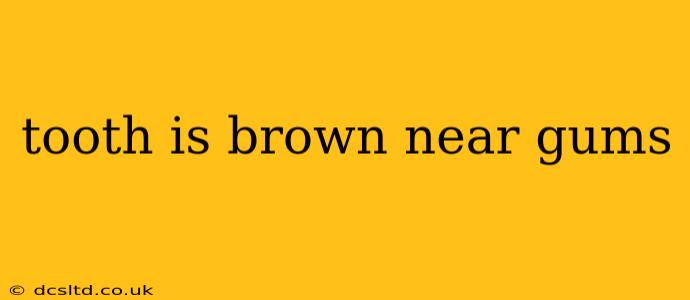Have you noticed a brown discoloration near the gum line of one or more of your teeth? This is a common concern that can stem from various factors, ranging from simple staining to more serious underlying issues. Understanding the causes is the first step towards addressing this aesthetic and potentially health-related problem. This comprehensive guide will explore the reasons behind brown discoloration near the gums, available treatment options, and preventive measures you can take.
What Causes a Brown Discoloration Near the Gums?
Brown staining near the gum line isn't always a cause for immediate alarm, but it warrants attention. Several factors can contribute to this discoloration:
1. Poor Oral Hygiene: Insufficient brushing and flossing allow plaque and tartar to accumulate along the gum line. Over time, this buildup can stain the teeth, resulting in a brown discoloration, particularly noticeable near the gum where the build-up is often most concentrated.
2. Food and Drinks: Certain foods and beverages, like coffee, tea, red wine, and berries, are notorious for staining teeth. The pigments in these substances can adhere to the enamel, especially near the gum line which may be more porous.
3. Tobacco Use: Smoking and chewing tobacco significantly increase the risk of tooth discoloration. The nicotine and tar in tobacco products stain teeth, often leading to a dark brown or yellow-brown hue, particularly concentrated at the gum line.
4. Medications: Some medications can cause tooth discoloration as a side effect. Tetracycline antibiotics, for example, are known to stain developing teeth in children and can cause brown or gray discoloration. Certain antihistamines and antipsychotic medications may also contribute.
5. Dental Fluorosis: Excessive fluoride intake during tooth development can lead to dental fluorosis, causing white or brown spots or streaks on the teeth. This is more common in areas with highly fluoridated water.
6. Enamel Erosion: The loss of tooth enamel exposes the underlying dentin, which is naturally darker in color. This can result in brown discoloration, often more prominent near the gum line where enamel is thinner. Acidic foods and drinks, along with frequent vomiting (bulimia), can contribute to enamel erosion.
7. Age: As we age, the enamel naturally thins, making teeth more susceptible to staining and discoloration. This process can also lead to a yellowing or browning of the teeth, particularly noticeable near the gums.
8. Dental Trauma: Injury to a tooth can sometimes cause internal discoloration, resulting in a brown or gray hue that may be more visible near the gum line.
How is Brown Discoloration Near the Gums Treated?
The treatment for brown discoloration near the gums depends on the underlying cause. Options include:
1. Professional Cleaning: A thorough cleaning by a dental professional can remove plaque and tartar buildup, potentially lightening the discoloration.
2. Teeth Whitening: Over-the-counter or in-office teeth whitening treatments can help lighten stains caused by food, drinks, and tobacco. However, whitening may not be effective for discoloration caused by other factors.
3. Dental Bonding: In cases of minor enamel erosion or staining, a dentist may apply a tooth-colored resin (bonding) to cover the discoloration.
4. Veneers or Crowns: For more extensive discoloration or damage, porcelain veneers or crowns can be placed over the affected teeth to improve their appearance.
5. Addressing Underlying Medical Conditions: If the discoloration is due to a medical condition or medication side effect, working with your physician or dentist to address the root cause is crucial.
How Can I Prevent Brown Discoloration Near My Gums?
Preventing brown discoloration involves practicing good oral hygiene and making healthy lifestyle choices:
- Brush and floss regularly: Brush your teeth twice a day with fluoride toothpaste and floss at least once a day to remove plaque and food particles.
- Limit consumption of staining foods and drinks: Moderate your intake of coffee, tea, red wine, and other staining substances. Rinse your mouth with water after consuming these items.
- Avoid tobacco products: Smoking and chewing tobacco significantly increase the risk of tooth discoloration and other oral health problems.
- See your dentist regularly: Regular checkups and professional cleanings can help prevent and address discoloration early on.
This information is for general knowledge and does not constitute medical advice. Always consult a dentist for diagnosis and treatment of any oral health concerns. Early intervention is key to maintaining a healthy and aesthetically pleasing smile.
